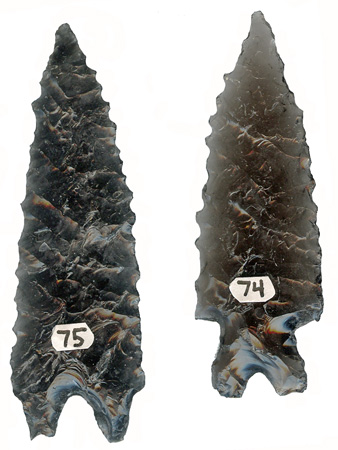

Point Type: PINTO
BASIN
Also See: Eastgate Bifurcated, Elko, Gatecliff, Humboldt, Northern, Rose
Valley
Location: Northwestern United States
Associated Dates: 8,000 - 2,650 B.P. -
Early Archaic to Late Archaic
Morphology: Bifurcate
General Description: The Pinto Basin is a small to medium sized
point, ranging in blade shape from triangular
to lanceolate. Its most
distinguishing feature is a short, concave or bifurcated stem
which may be straight, contracting or expanding slightly.
There are two major varieties of the Pinto Basin primarily
dealing with the variation in the haft
configuration: Pinto Square Shoulder and Pinto Sloping Shoulder.
There appears to be a great variability of the types in the Pinto Basin series
of points and more study and refinement of the type is needed. There
are variations in notching angles which effect the shoulders. In addition, the blade edges
exhibit variants such as serrations vs.
non-serrated as well as excurvate
to straight blade
edges.
The Pinto haft section, exhibits wide and shallow side
notching indentations on the side and notching of the base. The shape of
the basal ears
includes rounded to squared variations.
The apparent preforms of the type were of several shapes
varying between narrow ovate and trianguloid. Producing the basal notch
typically involved the removal of several flakes from each face, leaving a
rounded notch termination. The flaking pattern of the blade is typically
random but chevron flaking of one or both sides
of the blade is not uncommon. Pressure flakes
were detached to
create thin serrated edges and the follow the established contour of the blade
surface with feathered terminations.
The Pinto Basin point is found
in the Great Basin area of Nevada, southern Oregon, western Utah, eastern
California, southeastern Idaho and along the Pacific
Coast.
The age of the type has been identified as being
between 6000 to 2000 BC.
The principal material used in the manufacture
of the type was obsidian.
The Pinto Basin point type was named and defined by Charles Avery Amsden in a report by E.W.C. Campbell and W.H. Campbell published in 1935 for specimens found in the Pinto Basin site.
About the Point Above (Left): The Pinto Basin point pictured
at the top left of this page was found in
Oregon and is of the Sloping Shoulder variety. The point is made from a glossy
translucent black obsidian. Overall, the point measures 64 mm in length, is 21 mm
wide across the shoulders, and is only
5.8 mm thick in mid blade just above the shoulders. The stem is 9.3
mm long and is 14.5 mm wide across the auricles and the basal concavity
is 7.2 mm deep. The left auricle is slightly chipped. Catalog Number
75-46-H
About the
Point Above (Right): The Pinto
Basin point pictured at the top right of this page was found in Oregon and
is of the Square Shoulder variety. The point is made from a glossy highly
translucent black obsidian.
Overall, the point measures 59
mm in length,
is 21 mm wide across the shoulders, and is only 5.4 mm thick
in mid blade just above the shoulders. The stem is 12.3 mm long and is 15.4 mm
wide across the auricles and the basal concavity is 4.1 mm deep.
Catalog Number 74-46-H
References: Cassinelli, Hranicky (1), Justice (3), Overstreet,
Perino (1)
© Copyright 1997 - 2009 LITHICS-Net WWW.LITHICSNET.COM
Use your Browser's BACK Button to return to the LITHICS-Net Index.